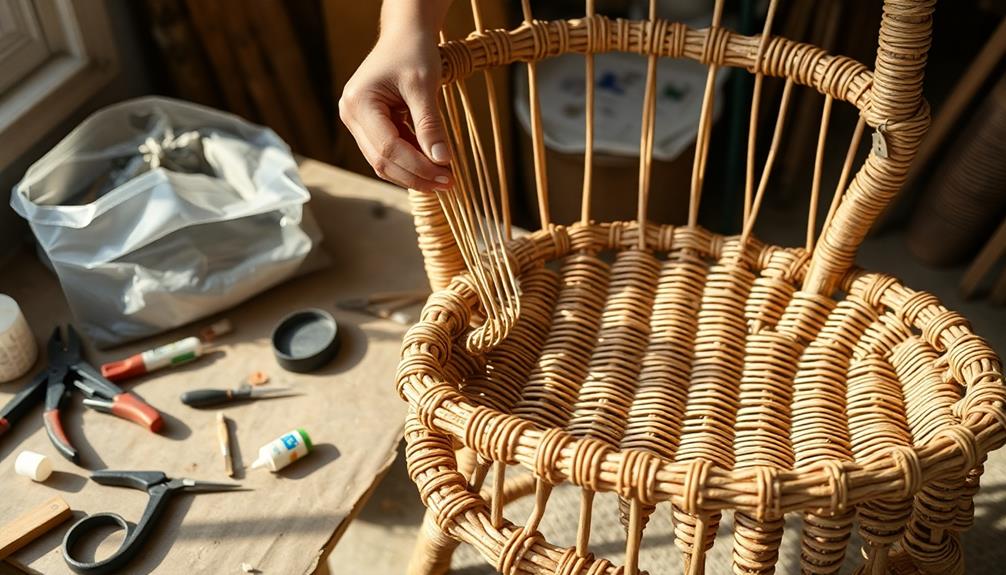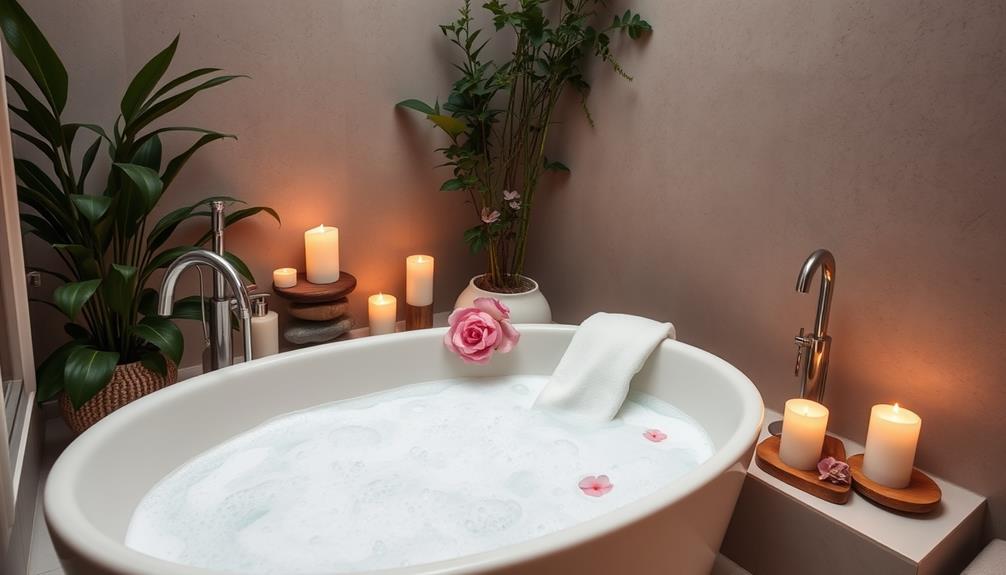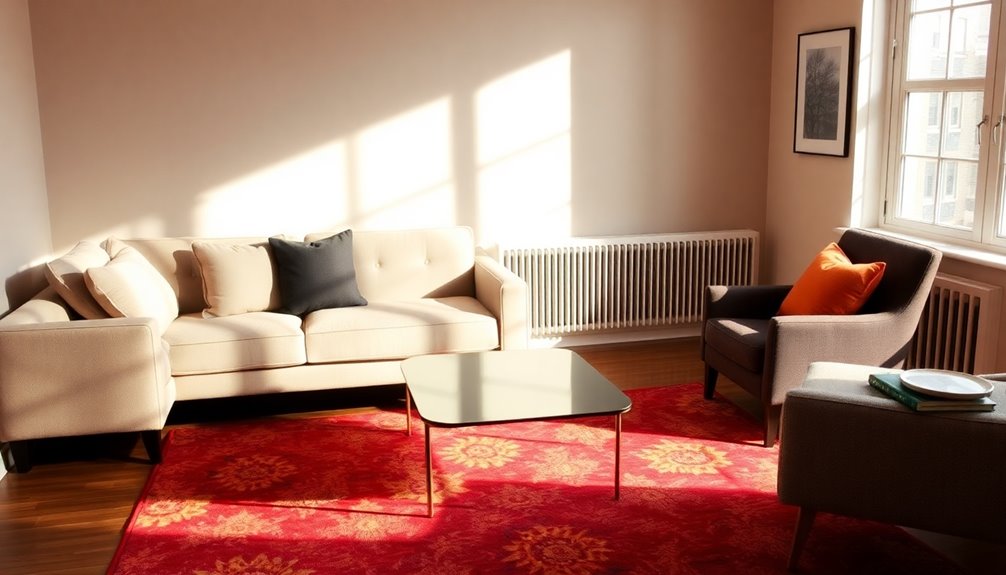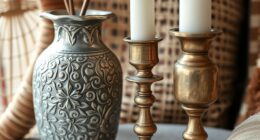To fix wicker furniture, begin by assessing the damage and checking for any loose or broken reeds. Carefully remove any damaged pieces while keeping the original pattern intact. Before securing them with waterproof wood glue, soak new replacement reeds in warm water to make them more flexible. It is crucial to follow the original weaving pattern to preserve the aesthetics. Regularly clean your wicker and consider applying a clear varnish to protect it from moisture and UV damage. Proper upkeep can significantly prolong its lifespan. Keep exploring these key tips to learn more about how to enhance the durability and charm of your wicker furniture.
Key Takeaways
- Regularly inspect wicker furniture for loose or broken reeds to address issues promptly and prolong lifespan.
- Use waterproof wood glue to secure loose reeds and ensure strong, lasting repairs.
- Soak replacement reeds in warm water for 30 minutes to enhance their flexibility during repairs.
- Follow the original weaving pattern closely when replacing reeds to maintain the furniture's aesthetic and structural integrity.
- Seal wicker with a clear varnish or polyurethane to protect it from moisture and UV damage.
Understanding Wicker and Rattan
When you plunge into the world of wicker furniture, it's essential to understand the distinction between wicker and rattan. Wicker refers to the weaving technique used to create furniture, while rattan is a specific material derived from climbing palms, often used in this crafting method. If you're considering wicker furniture, knowing these differences can guide your choices.
New England offers unique outdoor environments that could inspire your choice of wicker furniture for your home, as the region's natural beauty complements such pieces wonderfully. scenic views and natural beauty can enhance the ambiance of your living space, making it feel more connected to nature.
Rattan's natural beauty is appealing, but it's not water-resistant, making it less suitable for outdoor use. In contrast, synthetic wicker, made from materials like high-density polyethylene (HDPE), offers superior durability and moisture resistance. This makes synthetic wicker an excellent choice for outdoor settings, as it withstands the elements and UV exposure without degrading.
While rattan furniture is often reinforced with cane for added flexibility and moisture resistance, it requires regular maintenance to prolong its lifespan.
The ancient weaving technique of wicker has cultural significance, dating back to ancient Egypt. Understanding these materials and their properties can help you make informed decisions about which type of furniture best suits your needs and lifestyle.
Common Issues With Wicker Furniture
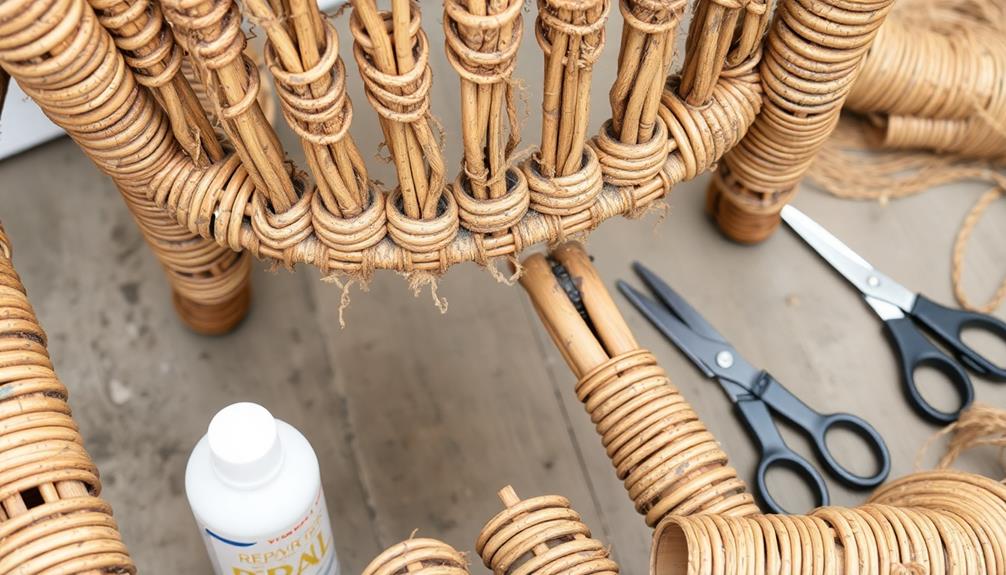
When you own wicker furniture, you might notice issues like fading and discoloration from sunlight exposure, which can be mitigated by applying appropriate protective finishes.
Additionally, broken or loose weaves can weaken the structure, making repairs essential. Addressing these common problems early on can help preserve your furniture's beauty and durability, ensuring it remains a cherished part of your home for years to come.
Moreover, keeping an eye on the overall condition of your furniture can prevent more significant issues, such as financial considerations for elderly care.
Fading and Discoloration
Fading and discoloration are common issues that can diminish the beauty of your wicker furniture over time. Prolonged exposure to direct sunlight is usually the main culprit, leading to significant color loss.
To tackle this problem effectively, contemplate the following steps:
1. Clean and Prepare: Before you apply any wood stains or outdoor paints, make certain to clean the surface thoroughly. Proper preparation guarantees better adhesion and a smoother finish.
You might also want to think about using essential oils, such as eucalyptus oil, which can be beneficial for maintaining a clean environment while working on your furniture.
2. Restore with Color: Use specific wood stains or outdoor paints to restore the original color of your wicker. Choose a shade that matches or complements your furniture's existing hue.
3. Apply Protective Coatings: To prevent future fading and discoloration, regularly apply clear varnish or polyurethane topcoats. These protective coatings provide essential UV protection and shield the material from moisture.
Addressing fading promptly can prevent further deterioration and maintain the overall aesthetic appeal of your wicker furniture.
With a little effort and regular maintenance, you can keep your pieces looking vibrant and beautiful for years to come.
Broken or Loose Weaves
Maintaining the beauty of your wicker furniture goes beyond addressing fading and discoloration; it also involves fixing broken or loose weaves.
Broken or loose pieces often occur due to environmental factors, wear and tear, or improper maintenance, which can compromise both the aesthetic appeal and structural integrity of your furniture.
To repair loose ends, start by applying wood glue to the base of the loose strands. Tuck these strands back into the wicker pattern and hold them in place for about 30 minutes until the glue sets.
For damaged reeds, carefully cut out the broken sections from the underside using heavy-duty scissors. Replace them with soaked replacement reeds, which will enhance flexibility during weaving.
When you're inserting new reeds, stagger the joins with the old ones to guarantee a seamless blend, maintaining the overall appearance of your wicker furniture.
Regular inspections and prompt repairs of loose or broken weaves can greatly extend the lifespan of your wicker furniture.
Cleaning and Maintenance Tips
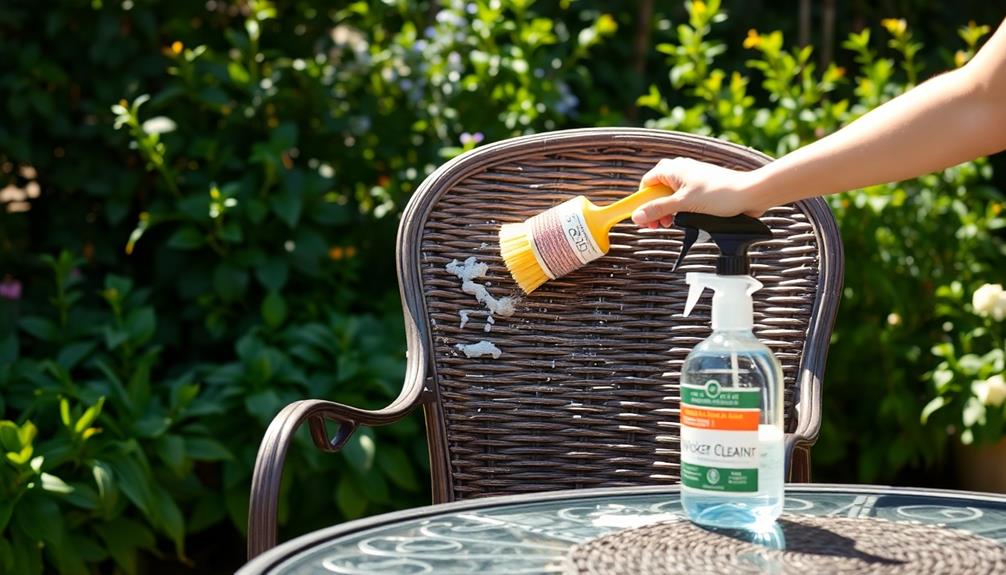
Regularly cleaning and maintaining your wicker furniture is essential to keep it looking great and prolong its lifespan. Start by dusting your furniture with a soft brush or vacuum to prevent dirt buildup. This simple step helps maintain both appearance and integrity.
For deeper cleaning, follow these tips:
- Use a Cleaning Solution: Mix mild soap with water to wipe down surfaces. Make sure to thoroughly rinse and dry the wicker afterward to prevent mold growth.
- Inspect Regularly: Conduct regular inspections for signs of wear and keep your wicker furniture in a dry environment, away from direct sunlight, to avoid fading.
- Tackle Mildew Spots: For mildew spots, use a solution of 50% hydrogen peroxide and 50% water, ensuring you apply it carefully.
Don't forget to remove cushions before cleaning. Machine wash removable covers and air dry them to keep them fresh and free from stains. To maintain the shape and comfort of your sofa, fluff the cushions regularly and rotate them to ensure even wear. For those wondering *how to repair sofa cushions* that have become too flat or worn-out, consider replacing the foam inserts or adding extra stuffing to revive their firmness. Taking these steps will extend the life of your sofa and keep it looking inviting for years to come. Additionally, it’s important to vacuum your sofa regularly to remove dust and debris, which can cause premature wear. If your sofa’s fabric becomes faded or outdated, learning *how to reupholster your sofa* can give it a fresh, modern look without the need to buy a new piece. With some basic tools and patience, reupholstering can transform an old, tired sofa into a statement piece that enhances your living space.
Tools and Materials Needed
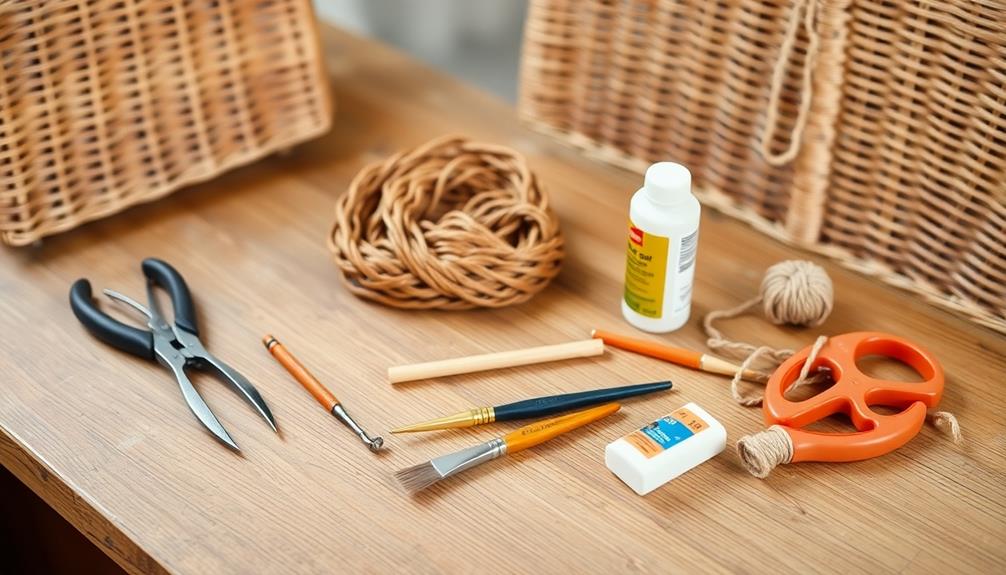
To repair your wicker furniture effectively, you'll need a few essential tools and materials.
Grab some heavy-duty scissors or an exacto knife, pliers, and waterproof wood glue to guarantee a solid fix.
You'll also want to have replacement reeds, a clean cloth for any mess, and possibly a wicker repair tool handy for those tight spots.
Essential Repair Tools
When tackling wicker furniture repairs, you'll need a few vital tools and materials to make the job easier and more effective. Having the right tools at your disposal will guarantee you can repair damaged wicker efficiently and achieve a polished finish.
Here are three vital tools you should gather:
- Wood Glue: This is essential for securing loose reeds and making sure that your repairs last.
- Heavy-Duty Scissors or Exacto Knife: Use these for cutting damaged sections of wicker. Having sharp tools will make your cuts clean and precise.
- Conventional Pliers: These are handy for gripping and manipulating reeds, especially when you're working in tight spots.
Additionally, don't forget to keep a clean cloth nearby. It's important for wiping away excess glue, making certain of a neat appearance during your repair.
If you're replacing wicker strands, consider using a wicker repair tool made from wire, as it can help weave replacement wicker strands through tight spots seamlessly.
Required Materials Overview
Repairing wicker furniture requires a well-thought-out selection of materials to assure a smooth and successful process.
First, you'll need replacement reeds that match the original in size and color, which you can find from wicker dealers or online. If you encounter damaged reeds, be prepared to cut them with heavy-duty scissors or an exacto knife.
Wood glue is essential for securing any loose ends, while super glue can be handy for smaller repairs. To assure a neat finish, keep a clean cloth nearby to wipe away any excess glue during the process.
For added flexibility, soak the replacement reeds in warm water before weaving them into your furniture. This step makes it easier to manipulate the reeds into tight spots.
A wicker repair tool, or a homemade option like a wire similar to a paper clip, can help with the weaving process as well.
With these materials in hand, you'll be well-equipped to tackle your wicker furniture repair and restore its beauty and functionality.
Steps for Repairing Wicker
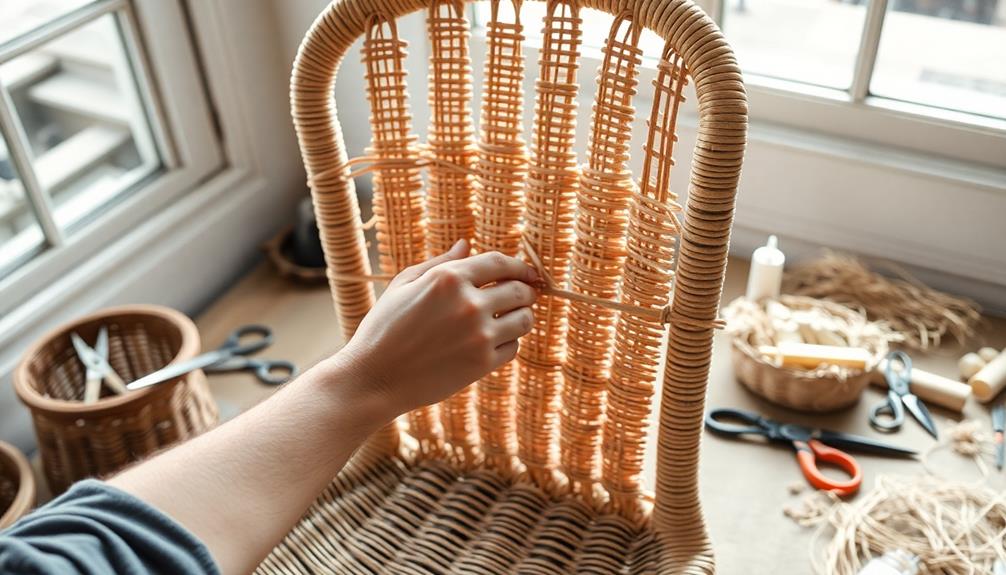
How can you effectively restore your wicker furniture? Start by evaluating the damage. Look for any loose reeds or broken pieces that need attention and document the extent of the damage to create a clear repair plan. Next, gently clean the wicker using a soft brush and mild soapy water to remove dirt and debris, which will give you a better view of the areas requiring repair. After cleaning, address any loose reeds by carefully weaving them back into place, securing them with a small amount of wood glue if necessary. While you’re working on wicker, consider other furniture that might need attention—restoring teak furniture can rejuvenate its look, just as wicker can benefit from proper care.
Here are the steps you should follow:
- Remove Damaged Reeds: Cut out any broken sections from the underside, preserving the original weaving pattern as much as possible for a seamless repair.
- Soak Replacement Reeds: Before you weave the new reeds into the existing pattern, soak them in warm water for about 30 minutes. This will increase their flexibility and make the process easier.
- Secure the Ends: Once you've woven the new reeds in, use wood glue to secure the ends. Tuck them in to prevent any sticking out, and hold them in place for several seconds to guarantee a strong bond.
Techniques for Restoring Wicker
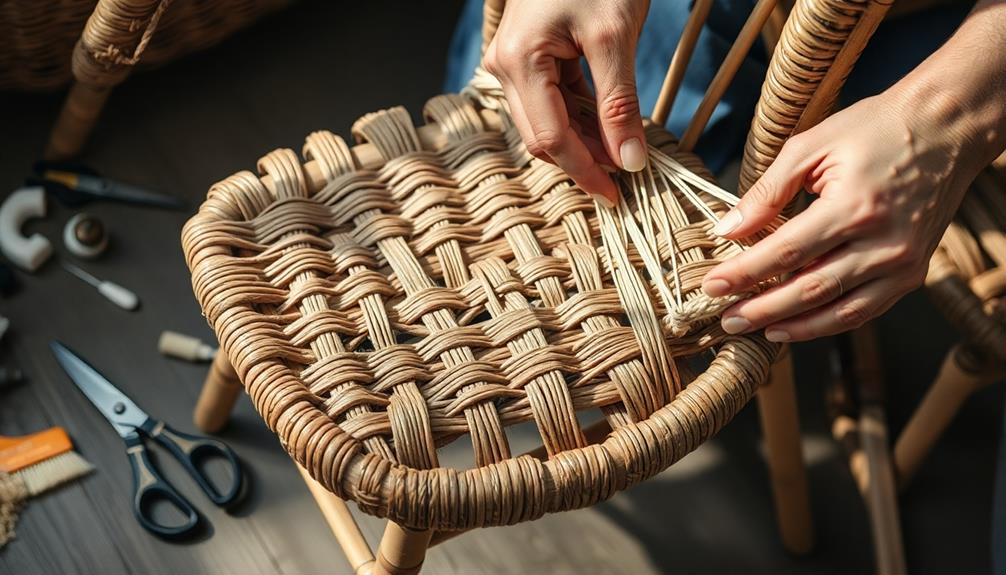
For effective restoration of wicker furniture, you'll want to employ a few key techniques that guarantee both functionality and aesthetics.
Start by evaluating the damage to identify any loose, broken, or missing reeds. This evaluation helps you plan your repairs effectively.
When you're ready to replace broken reeds, soak the new reeds in warm water for about 30 minutes. This will increase their flexibility, making it easier to weave them into the existing wicker pattern.
As you weave, follow the original pattern closely for seamless integration.
For loose ends and broken reeds, use wood glue to secure them. Apply a drop at the base and hold it in place for several seconds to ensure a strong bond as it dries.
This technique helps maintain both the structural integrity and overall appearance of your wicker furniture.
Protecting Wicker From Elements
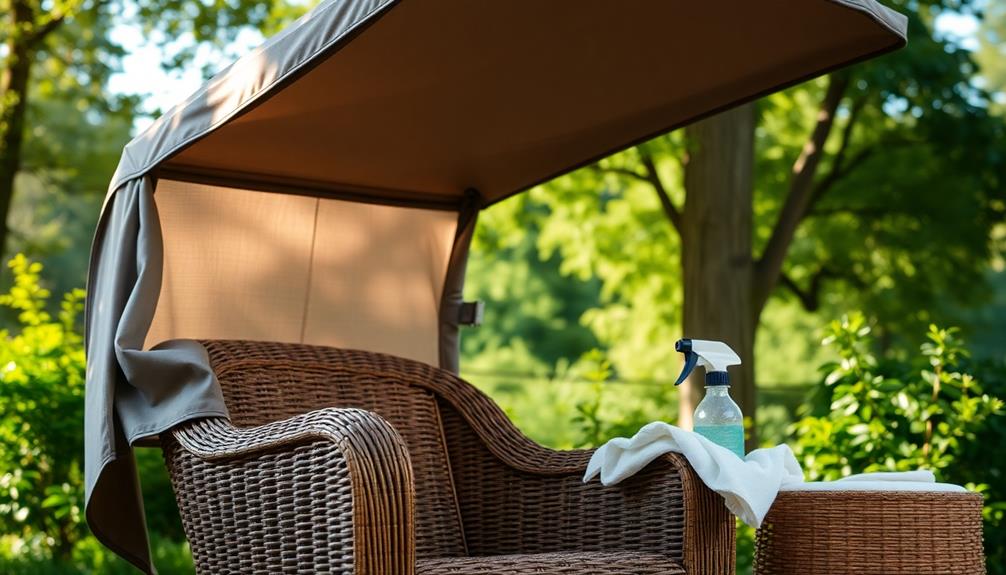
Wicker furniture can last for years if you take steps to protect it from the elements. Moisture and direct sunlight can compromise its integrity, leading to damage that may require repair.
Here are three essential tips to keep your wicker looking great:
- Seal with a Topcoat: Use a clear varnish or polyurethane topcoat to create a barrier against moisture. This helps prevent water damage and mildew formation.
- Regular Cleaning: Clean your wicker regularly with a mild oil-based soap mixed with water. This prevents stains and buildup, maintaining the furniture's integrity and appearance.
- Cover When Not in Use: When the weather turns inclement, cover your wicker furniture with a moisture-protecting tarp. This shields it from rain and humidity, which can cause lasting damage.
Avoid placing your wicker in direct sunlight, too. Consider using UV-protective sprays or covers to extend its color longevity.
Cost Considerations for Repairs

When it comes to repairing wicker furniture, understanding the costs involved can save you money and help you make informed decisions.
Repairing damaged wicker can often be more cost-effective than purchasing new pieces, especially if you're working with cherished items. DIY repairs usually require minimal tools and materials, making it a great option.
If you decide to go the professional route, expect to pay between $50 to $200 per hour. However, many simple repairs can be handled yourself.
Replacement reeds typically cost around $15 to $30 per half-pound coil, which is often enough for minor repairs. In contrast, new wicker furniture can be considerably more expensive.
Investing in high-quality adhesives, like E600 glue, usually costs between $5 to $10 per tube. This small expense can enhance the durability of your repairs and save you from frequent fixes in the future.
Additionally, regular maintenance, including cleaning and protective measures, can extend the lifespan of your wicker furniture. By staying proactive, you'll reduce the frequency and costs associated with repairs, ensuring your furniture remains in great shape for years to come.
Frequently Asked Questions
Is It Worth It to Repair Wicker Furniture?
It's definitely worth it to repair wicker furniture. You'll save money compared to buying new, extend the piece's life, and enjoy the satisfaction of restoring something special that adds character to your home.
Is There a Way to Repair Wicker?
Yes, you can repair wicker! Start by identifying damaged areas, carefully remove broken reeds, and replace them with new ones. Regular maintenance and gentle cleaning will help keep your wicker looking great for years to come.
What Is the Best Glue for Rattan Repair?
Did you know that about 70% of people prefer using industrial-strength glue for repairs? For rattan, E6000's your best bet. It bonds strongly, is waterproof, and dries clear, ensuring your repairs look great and last long.
What's the Difference Between Rattan and Wicker?
Rattan's a type of climbing palm known for its flexibility, while wicker's the weaving technique that can use various materials. So, rattan's the raw material, and wicker's how you create beautiful furniture from it.
Conclusion
With a little effort, you can transform your wicker furniture from a sad, sagging relic into a stunning centerpiece that'll make your neighbors green with envy. Remember, every twist and turn of your repair journey adds character and charm to your pieces. So, roll up your sleeves, grab those tools, and immerse yourself in the world of wicker restoration! You'll not only revive your furniture but also release a wave of creativity that'll leave a lasting impression on everyone who sees it.
